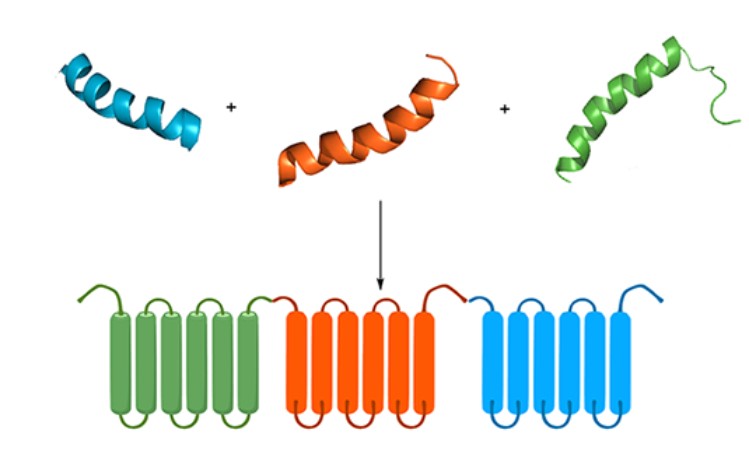Creative Peptides offers synthesis, modification and characterization of long peptides. Our scientists can evaluate the target peptide sequence and select the appropriate method for preparation. Based on current peptide technology and experience, customized peptides up to 100 amino acids or more in length are available.
Challenges and Strategies for Synthesizing Long Peptides
There are several challenges in the synthesis of long peptides, such as the large cumulative effect of yields, which can lead to slow or incomplete coupling and/or reverse protection during synthesis, and low solubility in protected peptide assembly. For the synthesis of long peptides, there are generally two ways of progressive growth and fragment condensation. The former starts from a starting amino acid (or peptide) and grows one amino acid per linkage. The latter is obtained by condensation of the C-terminal and N-terminal protecting peptides and the new peptide chain with the sum of the two.

Creative Peptides' Services for Synthesizing Long Peptides
Customization of Long Peptides
As one of the world's largest synthetic peptide producers, Creative Peptides has developed a variety of proprietary technologies, peptide manufacturing facilities, and expertise that allow us to offer high-volume, high-quality, and complex customized peptides ranging from research-grade to GMP production and provide you with the flexibility you need to customize your peptides. Creative Peptides offers customized peptides with long chain peptides with certain amino acid sequences, guaranteeing high purity and high success rate synthesis, providing you with high-quality long chain peptide products for your research or production. Currently we can provide the following synthesis techniques.
- Microwave synthesis method. For some difficult to condense amino acids in the synthesis process, we use microwave synthesis method, which is effective and greatly shortens the reaction time, and reduces the generation of two main by-products.
- Fragment synthesis method. When some peptides are difficult to synthesize and purify by conventional synthesis methods, we also use a few amino acids in a segment of the peptide as a whole after condensation to the peptide chain, and this method can also solve many of the problems in the synthesis.
- Hydrazide synthesis. Hydrazide synthesis is a method of peptide linkage by chemoselective reaction between a solid-phase synthesized N-terminal Cys peptide and a C-terminal peptide hydrazide to form an amide bond. According to the position of Cys in the peptide chain, the method divides the whole peptide chain into several sequences and synthesizes them separately, and finally the target peptide is obtained through liquid phase condensation reaction. This method not only greatly shortens the synthesis time of long peptides, but also significantly improves the purity of the final product, so it is widely used in the synthesis of long-chain peptides containing Cys.
- Acetylation. Acetylation is performed by introducing an acetyl (CH3CO-) group into the amino terminus of a long peptide. This modification increases the stability of the peptide chain, changes its hydrophilicity and lipophilicity, and affects its interaction and stability.
- Phosphorylation. The introduction of a phosphate group (PO43-) to specific residues in a long peptide, usually threonine, serine or tyrosine. Phosphorylation modifications can regulate the structure and function of proteins and are involved in biological processes such as cell signaling and metabolic regulation.
- Methylation. The introduction of a methyl (CH3-) group into specific residues of a long peptide. Methylation modifications can affect protein stability, subcellular localization, interactions, and have important regulatory effects on cellular processes and gene expression.
- Glycosylation. Glycosylation is the introduction of sugar groups into the amino acid residues of a long peptide. Glycosylation modifications can affect the stability, solubility, recognition and immunogenicity of proteins, and are involved in cell-cell interactions, signal recognition and other processes.
- Fatty acylation. By introducing fatty acyl groups (fatty acids), such as myoinositides, palmitoyl groups, to specific residues in long peptides. Fatty acylation modifications can regulate the hydrophilicity, lipophilicity and subcellular localization of proteins, affecting their functions and interactions.
Process Development of Long Peptides
Creative Peptides has established a mature development process and has significantly reduced process development time through significant process optimization. At the same time, Creative Peptides provides rational design assurance services for the process development of each long peptide molecule to ensure an economical and robust process with controlled product quality.
Quality Control of Long Peptides
Creative Peptides' quality management platform ensures that all steps in the peptide purification and quality control process are rigorously tested. Typical delivery specifications include:
- HPLC chromatogram
- Mass spec analysis
- Synthesis report
- Certificate of analyses
- Report for qualify evaluation
